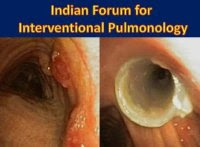Journal of Bronchology:
April 2010 - Volume 17 - Issue 2 - pp 122-125
doi: 10.1097/LBR.0b013e3181dc8c17
Original Investigations
Endobronchial Administration of Tranexamic Acid for Controlling Pulmonary Bleeding: A Pilot Study
Márquez-Martín, Eduardo MD; Vergara, Demetrio González MD; Martín-Juan, José MD, PhD; Flacón, Auxiliadora Romero MD, PhD; Lopez-Campos, José Luis MD, PhD; Rodríguez-Panadero, Francisco MD, PhD
Abstract
Background: Tranexamic acid (TA) is a synthetic antifibrinolytic substance used for short-term control of bleeding. However, control of pulmonary bleeding with endobronchial administration of TA in more than 2 cases has not been attempted earlier.
Objective: We tested the feasibility of endobronchial administration of TA for controlling pulmonary bleeding.
Methods: This was a 2-year prospective observational trial of endobronchial TA in consecutive patients presenting with hemoptysis to our bronchoscopy unit. Patients were initially treated according to the recommendations of the Spanish National Guidelines using ice-cold saline and adrenaline. Endobronchial administration of TA was attempted in patients with uncontrolled hemoptysis before proceeding with further interventions (balloon occlusion or embolization).
Results: Forty-eight patients (37 male; mean age: 64±13 y) were treated with endobronchial TA. The causes of bleeding were divided into iatrogenic (n=28) and noniatrogenic (n=20). Among patients with noniatrogenic bleeding, malignancies (11 patients) and bronchiectasis (10 patients) were the most frequent causes of hemoptysis. In this patient group, endobronchial TA successfully controlled the bleeding in 11 subjects (39.2%). Nonresponders to endobronchial TA suffered more frequently from bronchiectasis (58.3% vs. 18.8%, P=0.039) and less frequently from malignancies (16.7% vs. 56.3%, P=0.040) as compared with responders. All patients with iatrogenic bleeding were treated successfully with endobronchial TA. No subject in either of the patient groups suffered from thrombotic events or other adverse events related to endobronchial TA administration.
Conclusions: Patients with acute pulmonary bleeding may benefit from endobronchial instillation of TA. Further double-blinded controlled studies are necessary to confirm our results.




